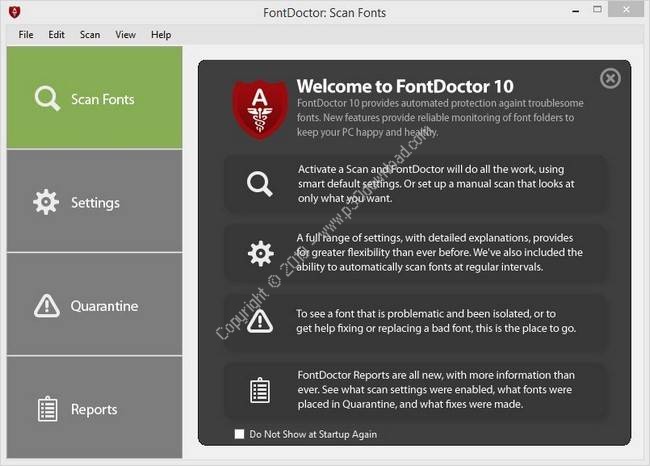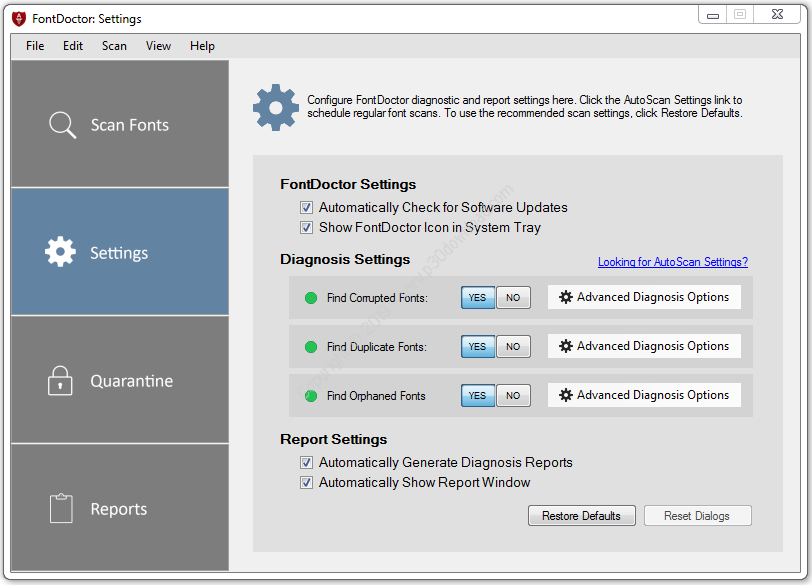- Fontdoctor 10 1 – Diagnose And Repair Damaged Fonts Onto
- Fontdoctor 10 1 – Diagnose And Repair Damaged Fonts Free
- Fontdoctor 10 1 – Diagnose And Repair Damaged Fonts Using
- Fontdoctor 10 1 – Diagnose And Repair Damaged Fonts Without
Reimage - a patented specialized Mac OS X repair program. It will diagnose your damaged computer. It will scan all System Files and Registry Keys that have been damaged by security threats. This patented repair process uses a database of 25 million components that can replace any damaged or missing file on user's computer. FontDoctor 10 (FontDoctor.exe). FontDoctor is a font diagnosis and repair software utility. The program can quarantine corrupt and malformed fonts, repair common font problems, generate detailed reports about bad fonts, weed out improperly organized font suitcases, and more. Give us a call 1-800-SAMSUNG (1-800-726-7864) Mobile Support 8 AM - 12 AM EST 7 days a week Home Electronics & Appliance Support 8 AM - 12 AM EST M-F 9 AM - 6 PM EST Sat, Closed Sunday. SIMATIC HMI WinCC V7.2 WinCC: General information System Manual Print of the Online Help 07/2013 A5E32316386-AB Service and Support 1 Migration 2 WinCC diagnosis. Explore the best Font Tools software for Mac. Browse our catalog of over 50 000 mac apps. MacUpdate is serving app downloads since 1997. Diagnose and repair damaged fonts. Show details Hide details.
Last updated on October 31st, 2017
Up to today I have seen and fixed several Windows 10 computers that were running slow, even new – and supposedly faster – PC's. According to my experience, Windows may be running slow due to several reasons that affect the system's performance.
The most common reasons that cause Windows (all versions) to run slow, are the following:
- Malware Infections.
- A large amount of programs that run at Windows Startup.
- Invalid Paging File (Virtual Memory) settings.
- Damaged hard drive.
In this tutorial I 'll show you how to troubleshoot and resolve slow performance issues on Windows 10 or Windows 8/8.1 based computers. *
* Note: Most of the steps below can be also applied on Windows 7 or Vista.
How to Optimize Windows 10/8/8.1 to run faster.
Step 1: Scan your computer for viruses and malware. Step 2. Remove Unnecessary Startup Programs. Step 3. Adjust Windows Performance Options Step 4. Turn off Windows Notifications. Step 5. Disable Defrag task. Step 6. Disable Useless or Culprit Services. Other solutions to fix Windows 10 Slow Performance. Step 1: Scan your computer for viruses and malware.Important:The first step to troubleshoot Windows 10 slow performance issues is to verifythat your computer is 100% clean from harmful programs like rootkits, malware or viruses. To accomplish this task, follow the steps from this Quick Malware Scan and Removal Guide.
Step 2. Disable Unnecessary Startup Programs.The second step to resolve the Windows performance issues in all Windows versions is to remove the useless files from your system and to eliminate the number of programs which run at Windows startup. You can perform that task easily with CCleaner:
1. Download and install CCleaner.
2. Run CCleaner and at the first screen, press the Run Cleaner button to clean the useless files from your computer (e.g. Temporary files, Temporary Internet Files, browser history, etc.)
3. Then choose Tools from the left menu and choose the Windows tab.
4.Disable (and not Delete if you are not sure about your choice) the startup applications that don't need to run at Windows Startup (e.g. Skype, OneDrive, etc.).
5.Restart your computer. *
* Note: If you are facing problems after the restart, run the CCleaner again and enable the disabled startup program(s).
Step 3. Adjust Windows Performance Options (Appearance, Virtual Memory).1. Right click on Computer icon (Name) and select Properties.
2. Click Change Settings.
3. At Advanced tab select Settings at Performance section.
4. At Visual Effects tab choose the 'Adjust for best performance' option and click Apply.
5. Then click the Advanced tab and select Change at Virtual memory* section.
* The Virtual Memory (also known as 'Paging File') is an amount of space on your disk that is used from Windows (and other OS) to 'extend' the installed physical memory, in order to run without problems.
6.Uncheck the 'Automatically manage paging file size for all drives' checkbox.
7.Check the 'Custom size' radio button.
8. Set the Initial size and Maximum size values to two and a half (2,5) times of your RAM size in MB* and then press the Set button. *
* For example: If your RAM's size is 4GB (4 x 1024MB = 4096MB), then type the value 10240 (4096MB x 2,5 = 10240MB) in the Initial & Maximum size (MB) fields.
9. Click OK three (3) times to exit.
10.Restart your computer.
Step 4. Turn off Windows Notifications.1. From Start menu, open Settings.
2. At settings window, select System.
3. Select Notifications & actions at the left and then set the Show me tips about Windows notifications to OFF.
4. Close settings window and check if your system runs smoothly. If the problem persists then try to turn off other notifications.
Step 5. Disable Defrag task.
1. At Cortana's search box type task scheduler.
2. Open the 'Task Scheduler' desktop app.
3. At the left pane go to Task Scheduler Library > Microsoft > Windows > Defrag.
Arturia mini filter 1 2 0 389 download free. 4. At the right pane select the Schedule Defrag task and click Disable.
5.Restart your computer.
Step 6. Disable Useless or Culprit Services.In many cases, the slow performance issues on Windows 10/8/8.1, are caused by non Windows services that are started with Windows or culprit Windows services that make Windows 10 to run slow. In this case, you have to disable these services until you find out which one is responsible for the slow performance. To accomplish this task:
Fontdoctor 10 1 – Diagnose And Repair Damaged Fonts Onto
1. Simultaneously press the Windows key + R keys to open the 'Run' command box.
2. In run command box, type: msconfig press Enter.

1. At Cortana's search box type task scheduler.
2. Open the 'Task Scheduler' desktop app.
3. At the left pane go to Task Scheduler Library > Microsoft > Windows > Defrag.
Arturia mini filter 1 2 0 389 download free. 4. At the right pane select the Schedule Defrag task and click Disable.
5.Restart your computer.
Step 6. Disable Useless or Culprit Services.In many cases, the slow performance issues on Windows 10/8/8.1, are caused by non Windows services that are started with Windows or culprit Windows services that make Windows 10 to run slow. In this case, you have to disable these services until you find out which one is responsible for the slow performance. To accomplish this task:
Fontdoctor 10 1 – Diagnose And Repair Damaged Fonts Onto
1. Simultaneously press the Windows key + R keys to open the 'Run' command box.
2. In run command box, type: msconfig press Enter.
3. At Services tab, check the Hide all Microsoft services checkbox.
4. Then press the Disable all button, to disable all non Windows services that start with Windows.
5. Finally click OK and restart your computer.
6. After the restart, if you still face slow performance issues, then run msconfig again, but this time disable (uncheck) the following services one-by-one: *
- Superfetch
- Windows Search
- Connected User Experiences and Telemetry
* Note: Each time disable only one service from the above list and restart your system. If, after the restart, the slow performance issue persists, then proceed and disable the next service from the above list – and restart again – until you find out which one of the mentioned services makes your computer to run slow.
Other solutions to fix Windows 10 Slow Performance.Fontdoctor 10 1 – Diagnose And Repair Damaged Fonts Free
Fontdoctor 10 1 – Diagnose And Repair Damaged Fonts Using
1. Keep Windows always updated.
2. Update Device's drivers. To accomplish this task, navigate to your computer's manufacturer support page and download and install all the latest drivers for your system's components (Chipset, Video Adapter, etc.).
3. Diagnose your hard disk for damages and replace it if needed.
4. Perform a clean Windows installation (after backing up your files).
5. Replace you hard drive with a solid state drive (SSD).
6. Increase System memory (RAM).
That's it! Let me know if this guide has helped you by leaving your comment about your experience. Please like and share this guide to help others.

